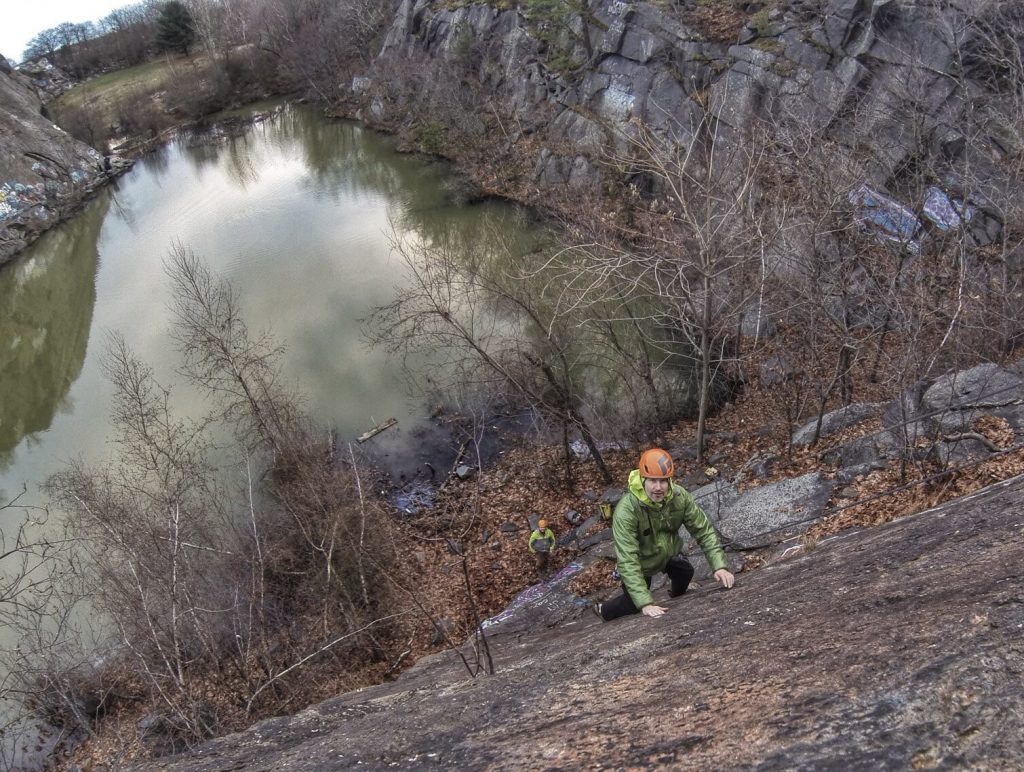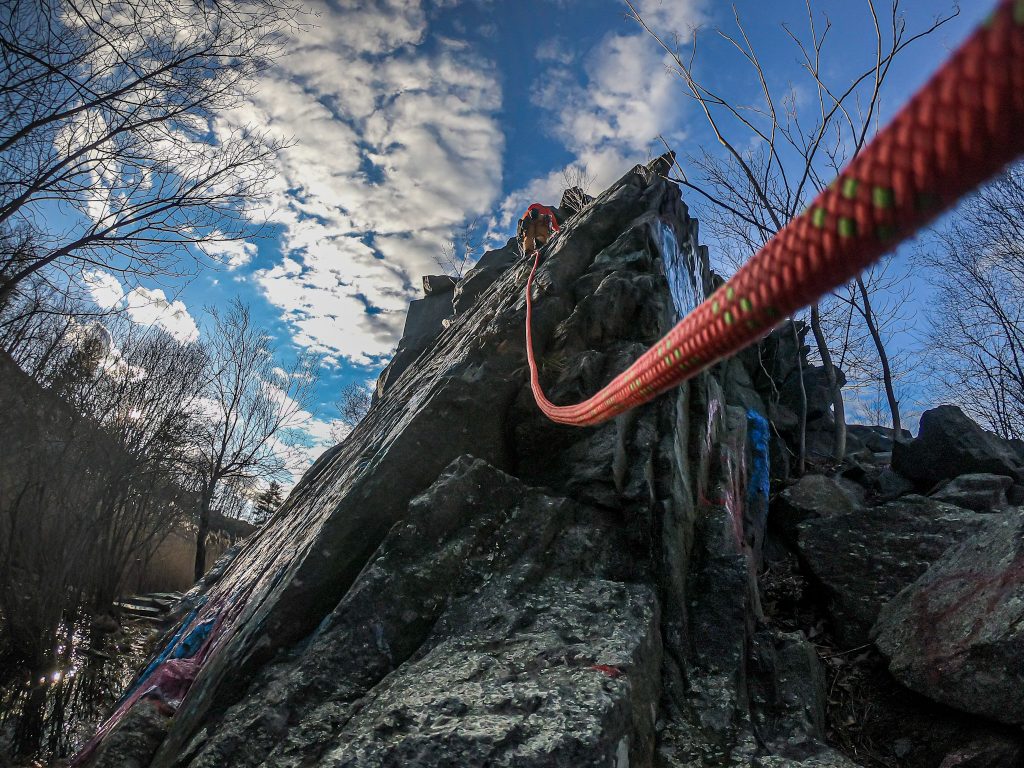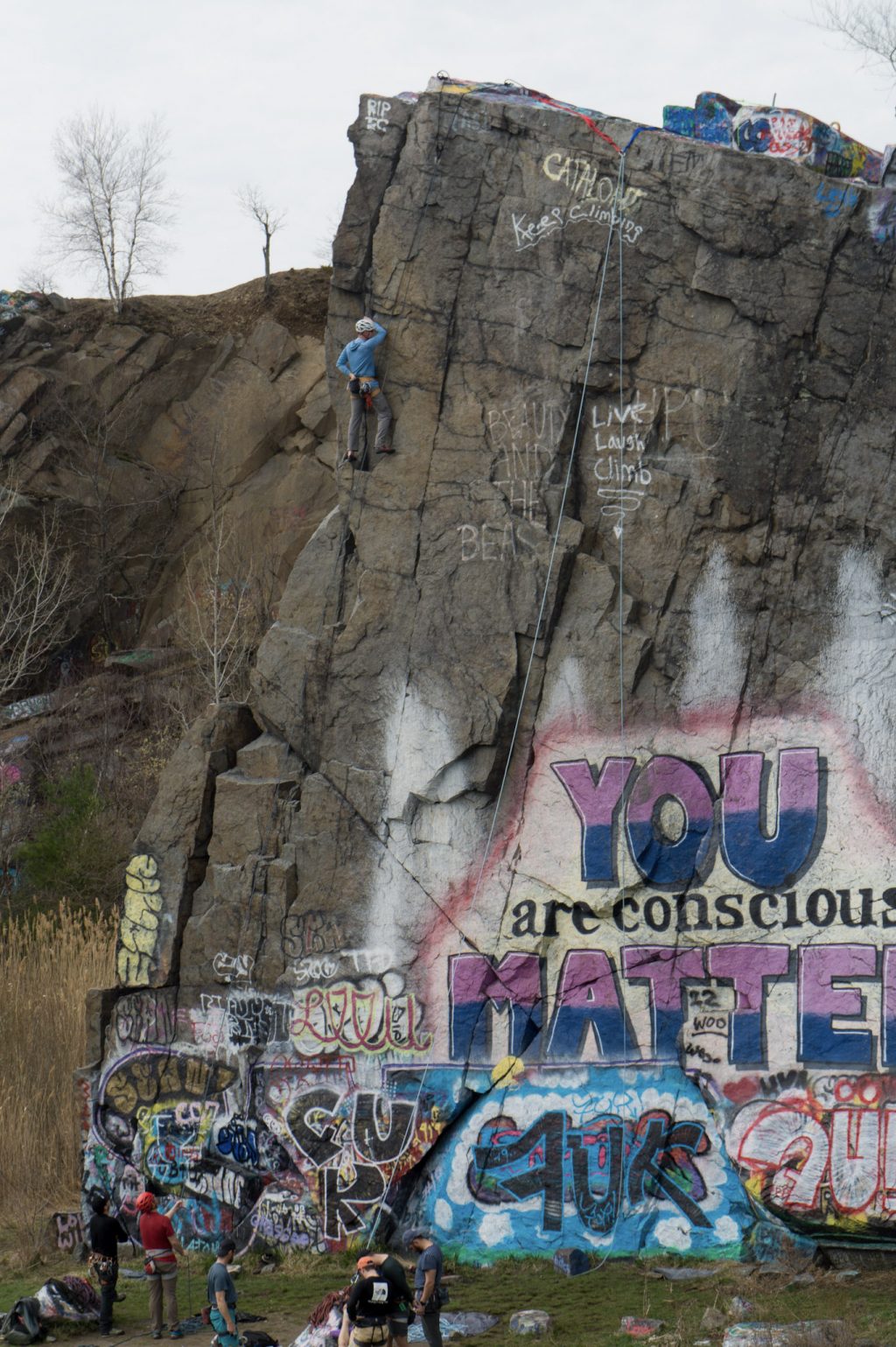Quincy Quarries (“QQ”) offers some of the best single-pitch climbing in the Greater Boston area. The set-ups are fast, the rock dries quickly after a storm, and the movement is great. Even better, the Quarries are climbable year round, making them a fantastic option for getting an early start on rock climbing season as well as extending Sendtember and Rocktober—keeping you cragging into November and beyond—as the temperatures drop at destinations like Cathedral, Whitehorse, Rumney, and the Gunks.

A Brief History of Quincy Quarries
The proximity of Quincy Quarries to Boston has made it a climbing destination since the 1920s when two of the nation’s leading climbers—Robert Underhill and Kenneth Henderson—began scaling its smooth granite walls as training for larger objectives in the Northeast and greater U.S. Underhill would make the first ascents of routes like the Eaglet in Franconia Notch and Mount Owen in the Tetons, while Henderson was also a first ascensionist of Mount Owen and established the classic alpine climb that bears his name on Mount Washington, Henderson Ridge.
A few decades would pass before a guidebook for QQ was published—A Climber’s Guide to the Quincy Quarries by Willie Crowther and Ray D’arcy. Like his predecessors, Crowther would establish area classics like Sliding Board at Whitehorse and Arrow at the Gunks. Now more than a half-century old, many climbs found in A Climber’s Guide to the Quincy Quarries remain challenging today.
Climbing at the “Qs,” as locals call it, took off in the late 1960s and continued through the 1970s and 1980s, as legendary climbers like Pete Cleveland, John Strand, and Henry Barber pushed grades in the area from 5.10 to 5.12. During that time, routes were established by boat or from the top down, as the main quarry was filled with over 200 feet of water. It wasn’t until the 2000s when the quarries were filled with dirt from the Big Dig that Qs took on the appearance they have today—albeit with more graffiti—and ground-up climbing became possible.

Routes Not to Miss
Whether you’re heading out for a post-work session or making a day trip to this historic locale, here’s a best-of list, one for each grade from 5.4 to 5.10. Know before you go that QQ ratings are sandbagged and the graffiti only adds to the challenge (and grade).
5.4: At the outer right-hand corner of the Cove, Boardwalk is a great mellow lead and the knife-edge ridge near the top offers a stellar perspective of the Quarries. Bring Black Diamond #3 and #4 cams to protect the moves at the top.
5.5: One of the first climbs you pass on the way into QQ, White Knight, would be one of the best routes in the Northeast if it went on for a few hundred more feet. Even at just 30-odd feet, the climbing is super-fun and packs a variety of movements, including smearing, stemming, edging, underclinging, side pulling, and mantling. A good lead, White Knight is one of several routes on Knight’s Face that is easily top-roped from anchors atop the route.
5.6: As you’ll learn in the sequency section that leaves the starting block, Layback is old-school 5.6. Commit to the layback, smear your feet on the smallest of spray-painted nubbins, and work your way up the first few moves. As you move through the initial sequence, look for better feet on some small ledges on the right. The climbing mellows the higher you get, but the gear starts to disappear and the top is a tad runout.
5.7: Located a little left of Layback, Lurch is a fun, balancey route that climbs an obvious paint streak on J Wall. Easily top-roped from a two-bolt anchor above, the route starts left of the paint streak, intersecting it at half-height. Above, the climbing weaves back and forth around the paint streak (crux) before reaching the top. For a bit harder challenge, check out the direct start, Lurch Direct (5.10), which begins on thin edges directly below the paint streak.
5.8: Outside Corner on K Wall is the most popular climb at the Qs for good reason: it’s the best sandbagged 5.8 in Greater Boston. There’s a bouldery crux down low, some moderate, thoughtful steps in the middle, and a few delicate moves into a strenuous crack near the top—all of which make this route a great lead and a common top rope.
5.9: Pins is another climb on K Wall that packs a punch. Like its neighbor, Outside Corner, it too is sandbagged. The route starts on spray-painted holds before transitioning to a 20-foot section of sustained, difficult laybacking up a crack and adjacent flake. Above that, the climbing eases, but many get so pumped that they don’t make it there. A popular top rope from the same anchor as Outside Corner, it also protects well on lead.
5.10: Ladder Line may be the best line at Quincy Quarries for sustained technical movement. It begins with a seemingly impossible start on the tiniest of spray-painted holds, transitions into several balancey sequences, and ends with a final crux up high. Can’t get past the start that is definitely much harder than 5.10? Consider bypassing it by traversing into the climb via the start of Layback or Lurch Direct.
For beta on the many other routes at Quincy Quarries, check out the seminal guidebook for climbing in the Greater Boston area—Boston Rocks.

Quincy Quarries Rack
A typical gear list for QQ includes:
- A personal climbing kit for each climber: harness, helmet, climbing shoes, chalk bag, a few locking carabiners, a belay device, and approach shoes with sticky rubber.
- For leaders, a rack containing a set of nuts and a single rack of cams to #4 with doubles of 0.4/0.5/0.75/#1 is great. A mix of sport and alpine draws will nicely round out your rack.
- For top-ropers, material to build anchors—a long static line (100 feet is optimal) and several locking carabiners will allow you to set up most anything at the Qs.
- Whether you’re leading or top-roping, a 60-meter rope is perfect for climbing at the Quarries.
- A large pack to carry essentials like food, water, layers, and a first aid kit.
Pro Tips
- Bring a static line. While some routes at Quincy Quarries have bolted anchors for top roping, many do not. Having a long-ish static line (100 feet) in your kit makes setups a breeze.
- Wear a helmet. It’s common for non-climbers to scramble around the tops of the cliffs, which makes debris falling from above a real threat.
- Opt for approach shoes. The sticky rubber adds security while scrambling around the top of slick granite cliffs while shoes offer protection against the broken glass found in many areas—leave the flip flops at home.
- A key to having a great day at Quincy Quarries is setting up in spots that afford access to multiple routes from the same anchor. This means more climbing and less anchor building. C Wall, K Wall, and Knight’s Face offer the most options for this.
- For those looking to rock climb outdoors all winter, the area around B Wall, C Wall, and D Wall—known to locals as the Cove—is like a reflector oven. On sunny days, the routes here are much warmer than the ambient air temperature and the climbing is good.

EMS Climbing School
Interested in climbing at Quincy Quarries, but not ready to take the sharp end or set up a top rope? No worries. EMS Climbing School guides have logged serious time in the Granite City. They can help you send the best the Quarries have to offer as well as teach you the skills necessary to climb there on your own.
EMS Climbing School
The Eastern Mountain Sports Climbing School is the oldest climbing school in the East. It has offered technical rock climbing instruction since 1968 and is one of less than 40 guide services in the US accredited by the American Mountain Guides Association (AMGA).
The EMS Climbing School helps people achieve their adventurous goals, whether it's climbing an iconic route, skiing a dream line, building technical skills, or sharing valuable beta.
Related Posts
April 12, 2024
Explore Like a Local: The Outdoor Mecca of North Conway, NH
There's a lot to love about this New…
April 3, 2024
5 Things To Do in the Boston Area During Mud Season
Adventure opportunities are abundant…




